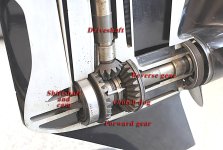1998 60hp Mariner. I'm having problems going from natural to reverse. I have the lower unit apart and the clutch and gears looks close to new. I try to push the pin in by hand to move the clutch and can't do it. The only way to push it in to engage it to the gear is to put it against a piece of wood and lean on it. Does this sound normal or does it sound like the spring is way to tight. I stripped out my shifter trying to get in reverse. It's always been a little hard to get in R but now it's taking a lot of pressure to get into R. Also with the propeller shaft out should the shift shaft spin freely by hand. I can spin by hand but it takes some force.
Home
Outboard Motor Parts
Chrysler outboard parts Evinrude outboard parts Force outboard parts Honda outboard parts Johnson outboard parts Mariner outboard parts Mercury outboard parts Suzuki outboard parts Tohatsu outboard parts Yamaha outboard partsInboard & Sterndrive Engine Parts
Chrysler Marine inboard parts Crusader Marine parts MerCruiser sterndrive parts OMC sterndrive parts Pleasurecraft Marine parts Volvo Penta marine parts + MoreAll Engine Brands
All Manuals HomeOutboard Repair Manuals
Chrysler outboard manuals Evinrude outboard manuals Force outboard manuals Honda outboard manuals Johnson outboard manuals Mariner outboard manualsMercury outboard manuals Nissan outboard manuals Suzuki outboard manuals Tohatsu outboard manuals Yamaha outboard manuals
Inboard & Sterndrive Engine Manuals
MerCruiser sterndrive manuals OMC sterndrive manuals Volvo Penta marine engine manualsPlease Note
MarineEngine.com does not offer troubleshooting assistance or repair advice by email or by telephone.
You are invited to join our public Boat Repair Forum to seek assistance from other members.
You may also visit the Boat Motor Manuals section of our site to obtain a service manual.


